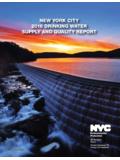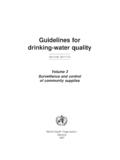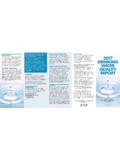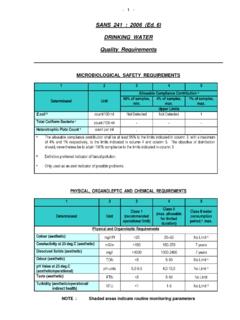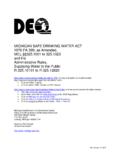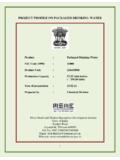Transcription of Guidelines for Drinking-water Quality
1 Guidelines for Drinking-water QualityFIRST ADDENDUM TO THIRD EDITIONV olume 1 RecommendationsWHO Library Cataloguing-in-Publication DataWorld Health for Drinking-water Quality [electronic resource] :incorporating first addendum. Vol. 1, Recommendations. version for the water Quality I. 92 4 154696 4(NLM classification: WA 675) World Health Organization 2006 All rights reserved. Publications of the World Health Organization can be obtained from WHO Press, WorldHealth Organization, 20 Avenue Appia, 1211 Geneva 27, Switzerland (tel:+41 22 791 3264; fax:+41 22 7914857; email: Requests for permission to reproduce or translate WHO publications whether for sale or for noncommercial distribution should be addressed to WHO Press, at the aboveaddress (fax:+41 22 791 4806; email: designations employed and the presentation of the material in this publication do not imply the expres-sion of any opinion whatsoever on the part of the World Health Organization concerning the legal statusof any country, territory, city or area or of its authorities, or concerning the delimitation of its frontiers orboundaries.))
2 Dotted lines on maps represent approximate border lines for which there may not yet be mention of specific companies or of certain manufacturers products does not imply that they areendorsed or recommended by the World Health Organization in preference to others of a similar naturethat are not mentioned. Errors and omissions excepted, the names of proprietary products are distinguishedby initial capital reasonable precautions have been taken by WHO to verify the information contained in this publica-tion. However, the published material is being distributed without warranty of any kind, either expressedor implied. The responsibility for the interpretation and use of the material lies with the reader. In no eventshall the World Health Organization be liable for damages arising from its and abbreviations used in textxx1.
3 Considerations and and responsibilities in Drinking-water safety and Quality health resource supply documentation to the Guidelines182. The Guidelines : a framework for safe for safe Drinking-water : assessment and plans, documentation and of Drinking-water quality28 Guidelines FOR Drinking-water for water water Drinking-water , regulations and national priority Drinking-water Quality microbial chemical priorities353. Health-based and purpose of health-based of health-based technology Quality outcome considerations in establishing health-based of risk in the framework for safe level of life-years (DALYs)454. water safety assessment and and evaluating available and source distribution , community and household and monitoring and maintaining system control operational monitoring operational and critical , community and household of microbial of chemical distribution for community-managed assurance and Quality procedures for piped distribution incidents ( deviations ) [ in first addendum to third edition] a monitoring of community and household water and communication825.
4 Of approaches to specific areas in developing of community Drinking-water of household treatment and storage of (service level) and and with community and use of data966. Application of the Guidelines in specific risk surveillance and supporting Quality in health care Quality in schools and day care and guidelines107 Guidelines FOR Drinking-water inspections and catchment and radiological kits and Drinking-water for of packaged health benefits of bottled standards for bottled production and and risk risk Microbial hazards associated with and growth in health target targets applied to microbial assessment performance target the outcome of performance in adapting risk-based performance target settingto national/local outcome and treatment of of microbial safety and of detection of faecal indicator bacteria143 Guidelines FOR Drinking-water local actions in
5 Response to microbial water Quality problems and water and water avoidance following an incident144cCONTENTSvii8. Chemical hazards in of chemical guideline guideline with effects on disinfection carbon treatment by-products process control for corrosion values for individual chemicals, by source occurring from industrial sources and human from agricultural used in water treatment or from materials in contact with used in water for public health local actions in response to chemical water Quality problems and for the to the right the the significance to public health and appropriate remedial action, preventing recurrence and updating the water safety water avoidance advisories196f9. Radiological and health effects of radiation exposure through health effects through drinking -water200 Guidelines FOR Drinking-water of radioactivity and radiation levels for radionuclides in and assessment for dissolved of Drinking-water for assessing in air and on radon in Drinking-water , analysis and gross alpha and gross beta activityconcentrations207[ in first addendum to third edition] of results20910.
6 Acceptability , odour and derived derived of taste, odour and appearance Microbial fact colipathogenic A E and and index coliform coliand thermotolerant coliform plate viruses29412. Chemical fact and acetic hydrate (trichloroacetaldehyde) and (2-chlorophenol, 2,4-dichlorophenol,2,4,6-trichlorophenol ) ,4-D (2,4-dichlorophenoxyacetic acid) , and ,2-Dibromo-3-chloropropane (DBCP) ,2-Dibromoethane (ethylene dibromide) (1,2-dichlorobenzene, 1,3-dichlorobenzene,1,4-dichlorobenzene) , , , ,2-Dichloroethene355 Guidelines FOR Drinking-water ,2-Dichloropropane (1,2-DCP) , , (2,4-DP) (2-ethylhexyl) (2-ethylhexyl) (a) 1, acid (EDTA) (2,4,5-TP; 2,4,5-trichlorophenoxy propionic acid) and acetonitriles (dichloroacetonitrile,dibromoacetonitril e, bromochloroacetonitrile,trichloroacetoni trile) and heptachlor (HCB) (HCBD) [4-(2-methyl-4-chlorophenoxy)acetic acid] (MCPP.)
7 [2(2-methyl-chlorophenoxy) propionicacid]) parathion404 Guidelines FOR Drinking-water (a)Methyl tertiary-butyl ether (MTBE) FOR Drinking-water and acid (NTA) (PCP) (a) Petroleum 2-Phenylphenol and its sodium Polynuclear aromatic hydrocarbons (PAHs) 2,4,5-T (2,4,5-trichlorophenoxyacetic acid) Terbuthylazine (TBA) Total dissolved solids (TDS) Trichloroacetic Trichlorobenzenes (total) 1,1, Trihalomethanes (bromoform, bromodichloromethane,dibromochloromethan e, chloroform) Vinyl Zinc459 CONTENTS xiiiAnnex 1 Bibliography461 Annex 2 Contributors to the development of the third edition of theGuidelines for Drinking-water Quality467[Annex 3 Deleted in first addendum to third edition]Annex 4 Chemical summary tables488 Index494xvPrefaceAccess to safe Drinking-water is essential to health, a basic human right and a com-ponent of effective policy for health importance of water , sanitation and hygiene for health and development hasbeen reflected in the outcomes of a series of international policy forums.
8 These haveincluded health-oriented conferences such as the International Conference onPrimary Health Care, held in Alma-Ata, Kazakhstan (former Soviet Union), in have also included water -oriented conferences such as the 1977 World WaterConference in Mar del Plata, Argentina, which launched the water supply and sanita-tion decade of 1981 1990, as well as the Millennium Development Goals adopted by the General Assembly of the United Nations (UN) in 2000 and the outcome of theJohannesburg World Summit for Sustainable Development in 2002. Most recently,the UN General Assembly declared the period from 2005 to 2015 as the InternationalDecade for Action, water for Life. Access to safe Drinking-water is important as a health and development issue at anational, regional and local level.
9 In some regions, it has been shown that investmentsin water supply and sanitation can yield a net economic benefit, since the reductionsin adverse health effects and health care costs outweigh the costs of undertaking theinterventions. This is true for major water supply infrastructure investments throughto water treatment in the home. Experience has also shown that interventions inimproving access to safe water favour the poor in particular, whether in rural or urbanareas, and can be an effective part of poverty alleviation 1983 1984 and in 1993 1997, the World Health Organization (WHO) publishedthe first and second editions of the Guidelines for Drinking-water Qualityin threevolumes as successors to previous WHO International Standards. In 1995, the decision was made to pursue the further development of the Guidelines through aprocess of rolling revision.
10 This led to the publication of addenda to the second editionof the Guidelines , on chemical and microbial aspects, in 1998, 1999 and 2002; thepublication of a text on Toxic Cyanobacteria in water ; and the preparation of expertreviews on key issues preparatory to the development of a third edition of the FOR Drinking-water QUALITYxviIn 2000, a detailed plan of work was agreed upon for development of the thirdedition of the Guidelines . As with previous editions, this work was shared betweenWHO Headquarters and the WHO Regional Office for Europe (EURO). Leading theprocess of the development of the third edition were the Programme on water Sanitation and Health within Headquarters and the European Centre for Environ-ment and Health, Rome, within EURO.










